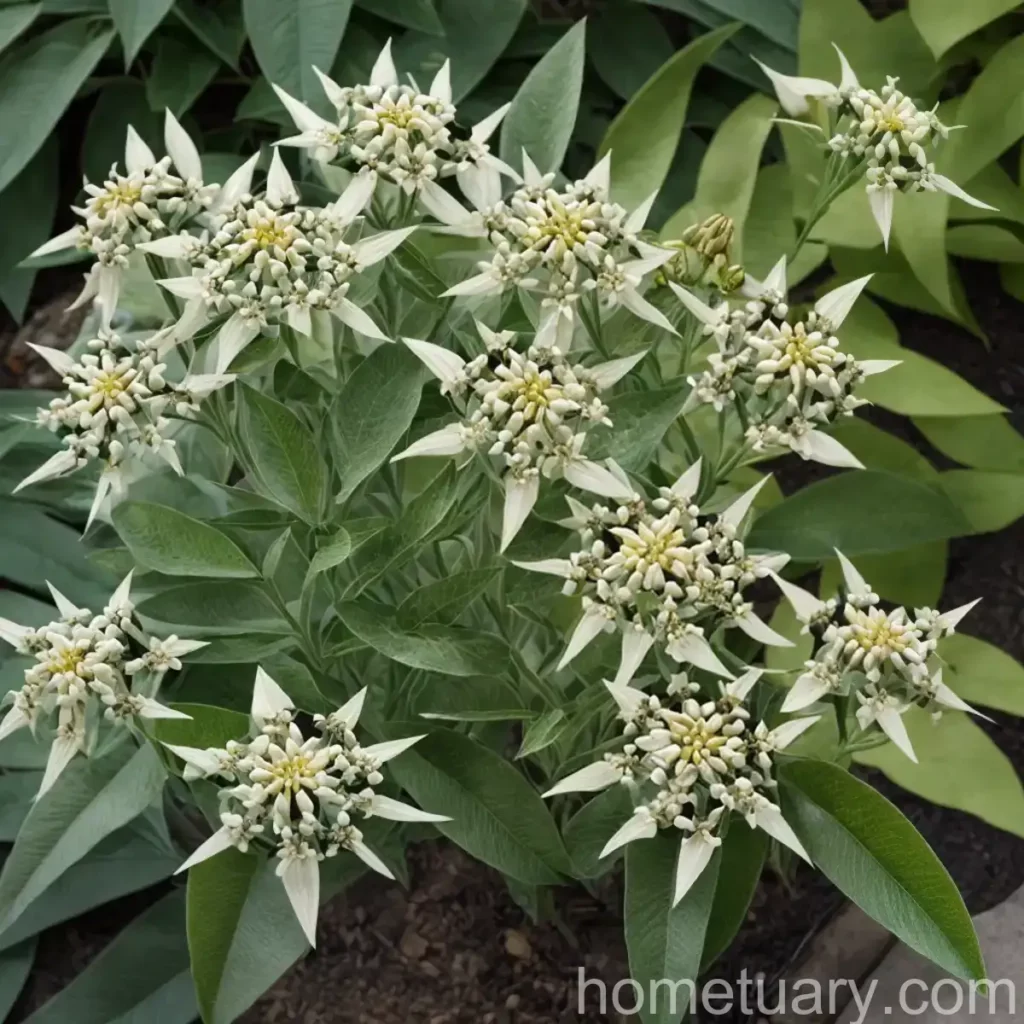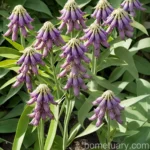Fourleaf Milkweed (Asclepias quadrifolia)
Fourleaf milkweed, scientifically known as Asclepias quadrifolia, is a captivating plant that belongs to the milkweed family, Asclepiadaceae. This native perennial herbaceous plant is primarily found in the eastern United States and parts of Canada. As a plant scientist with a passion for biodiversity and conservation, I am excited to delve into the world of the fourleaf milkweed. In this comprehensive guide, we will explore its characteristics, optimal culture, uses, and management of diseases and pests.
What is Fourleaf Milkweed?
Fourleaf milkweed, also known as the Fourleaf milkweed or Whorled milkweed, is a distinct species in the milkweed genus. It is characterized by its unique whorled leaves, which inspired its common name. This plant typically thrives in dry, rocky woodlands and is known for its appealing foliage and vibrant blooms, making it a valuable addition to native plant gardens and natural habitats.
Key Characteristics
Here are some key characteristics of the fourleaf milkweed:
- Scientific Name: Asclepias quadrifolia
- Family: Asclepiadaceae
- Habitat: Dry, rocky woodlands
- Leaves: Whorled arrangement
- Blooms: Clusters of small, star-shaped, greenish-white flowers
- Attracts: Butterflies, bees, and other pollinators
- Height: Typically grows up to 1-2 feet tall
Now that we have a brief overview of this fascinating plant, let’s dive deeper into its culture, uses, and management.
Culture
Water
Proper watering is essential for the well-being of fourleaf milkweed. It is crucial to ensure that the plant receives adequate moisture, especially during the initial stages of growth and establishment. However, once established, fourleaf milkweed demonstrates a good level of drought tolerance and can thrive in relatively dry conditions. The key is to find the right balance, avoiding over-watering, which can lead to root rot, and under-watering, which can stunt growth and reduce flowering.
Sunlight
Fourleaf milkweed flourishes in full to partial sunlight. When selecting a planting location, it is important to choose a spot that receives at least 6 hours of sunlight per day for optimal growth and blooming. In shaded areas, the plant may become leggy and produce fewer blooms, so providing adequate sunlight is crucial for its overall health and appearance.
Soil
The ideal soil for fourleaf milkweed is well-draining and slightly acidic to neutral. It thrives in sandy or loamy soils and is somewhat tolerant of poorer soil conditions. Adding organic matter, such as compost, can help enhance the soil structure and fertility, providing an excellent growing medium for the plant.
Fertilizer
In most cases, fourleaf milkweed does not require regular fertilization. Excessive fertilization can lead to an overgrowth of foliage at the expense of flowers and may attract pests. If the soil is deficient in nutrients, a balanced, slow-release fertilizer can be applied sparingly in the early spring before new growth emerges. However, it is crucial to avoid high-nitrogen fertilizers, as they can negatively impact the overall health of the plant.
Uses
Fourleaf milkweed offers various uses, ranging from its ecological significance to its potential medicinal properties and landscaping appeal.
Ecological Significance
- Pollinator Habitat: The flowers of fourleaf milkweed serve as a valuable nectar source for butterflies, bees, and other pollinators, supporting biodiversity in natural ecosystems.
- Butterfly Host Plant: As a host plant for monarch butterflies, fourleaf milkweed plays a vital role in supporting the breeding and survival of this iconic species.
Medicinal Potential
While not as extensively studied as common milkweed species, some native American tribes are believed to have used parts of the plant for medicinal purposes. However, it is important to note that the use of any plant for medicinal reasons should be approached with caution and under the guidance of a knowledgeable healthcare provider.
Landscaping
The unique foliage and attractive blooms of fourleaf milkweed make it a popular choice for native plant gardens, natural landscaping, and prairie restoration projects. Its low maintenance requirements and ecological benefits make it a valuable addition to sustainable landscapes.
Pruning
Pruning of fourleaf milkweed is generally minimal. Deadheading the spent blooms can encourage the plant to produce additional flowers and prevent self-seeding, especially if a more controlled growth pattern is desired. Any damaged or diseased growth should be promptly removed to maintain the overall health and appearance of the plant.
Propagation
Fourleaf milkweed can be propagated through both seeds and division. Here are some key points to keep in mind when propagating this plant:
- Seeds: Collect seeds from mature pods in the fall and sow them in a prepared seedbed. Cold stratification may enhance germination rates for some populations.
- Division: In early spring, division can be performed by carefully separating the rhizomes, ensuring that each division has sufficient roots and shoots for successful establishment.
Container Popularity
Due to its manageable size and relatively non-invasive nature, fourleaf milkweed is well-suited for container cultivation. This is particularly beneficial for individuals with limited garden space or those seeking to create butterfly-friendly habitats on patios, balconies, or rooftops.
Common Diseases
While fourleaf milkweed is generally resilient, it may occasionally encounter certain diseases that can affect its health and appearance. Some of the common diseases include:
- Powdery Mildew: This fungal disease may appear as a white powdery substance on the leaves, often caused by poor air circulation and high humidity.
- Leaf Spot: Dark lesions on the foliage may indicate the presence of leaf spot diseases, which can be triggered by excessive moisture and poor sanitation practices.
Disease Diagnosis
Diagnosing plant diseases requires careful observation and, at times, consultation with plant health specialists. Common symptoms of diseases in fourleaf milkweed include abnormal leaf discoloration, wilting, stunted growth, and unusual spots or patches on the leaves. If any of these symptoms are observed, it is essential to promptly take action to identify the specific disease and implement appropriate control measures.
Common Pests
In addition to diseases, fourleaf milkweed may also face challenges from various pests. Some of the common pests that can affect the plant include:
- Aphids: These small, sap-sucking insects can distort new growth and produce sticky honeydew, leading to the formation of sooty mold.
- Milkweed Bugs: Certain species of milkweed bugs may feed on the seeds and young foliage of the plant, potentially reducing its reproductive capacity.
Botanist’s Tips
As a botanist with a passion for native plant conservation, I have gathered some valuable tips for nurturing and appreciating fourleaf milkweed in your landscape:
- Support Wildlife: By cultivating fourleaf milkweed, you are providing essential support for pollinators and contributing to the preservation of biodiversity.
- Resist Chemical Controls: Whenever possible, opt for eco-friendly pest control methods and avoid the use of broad-spectrum pesticides that can harm beneficial insects.
- Educate Others: Share the significance of native plants like fourleaf milkweed with friends, family, and community members to inspire collective efforts in conservation.
Fun Facts
To appreciate the unique nature of fourleaf milkweed, here are some intriguing and lesser-known facts about this remarkable plant:
- Unlike common milkweed (Asclepias syriaca), which features opposite leaves, fourleaf milkweed exhibits whorled leaf arrangements, with leaves occurring in sets of four around the stem.
- The intricate flowers of fourleaf milkweed produce an abundance of nectar, attracting a diverse array of native pollinators.
- Monarch butterflies, in particular, rely on fourleaf milkweed as a crucial host plant for their caterpillars, highlighting the plant’s ecological importance.
Links to External Resources
Resources for Fourleaf Milkweed Enthusiasts
Here are some valuable external resources for individuals interested in further exploring the world of fourleaf milkweed:
- The Xerces Society for Invertebrate Conservation: An organization dedicated to the conservation of invertebrates and their habitats, providing information on milkweed species and pollinator conservation.
- Lady Bird Johnson Wildflower Center: A renowned botanical garden and research center, offering comprehensive resources on native plants, including Asclepias quadrifolia.
Conservation and Biodiversity
For those passionate about native plant conservation and the preservation of biodiversity, the following resources may prove invaluable:
- National Wildlife Federation: A leading conservation organization with a wealth of information on native plants and wildlife habitat preservation.
- The Nature Conservancy: An international nonprofit organization focused on land and water conservation, providing resources for native plant enthusiasts and conservationists.
Gardening and Sustainable Landscaping
For individuals keen on sustainable gardening and eco-friendly landscaping practices, the following resources offer practical insights and tips:
- American Horticultural Society: A trusted source for gardening advice, plant information, and resources for sustainable landscaping.
- National Garden Bureau: An organization dedicated to promoting gardening and horticulture, offering educational resources on native plants and pollinator-friendly gardening practices.
Conclusion
In conclusion, fourleaf milkweed (Asclepias quadrifolia) stands as an emblem of ecological significance, botanical beauty, and conservation value. By understanding the optimal culture, uses, and management considerations for this native plant, individuals can actively contribute to the conservation of biodiversity and create sustainable habitats for pollinators. Whether it be in a backyard garden, a community restoration project, or a natural landscape, the presence of fourleaf milkweed enriches the environment and invites appreciation for the wonders of native flora.
I hope this comprehensive guide has provided valuable insights into the world of fourleaf milkweed and inspired a deeper appreciation for its remarkable attributes and ecological importance. As plant enthusiasts and conservation advocates, let us continue to foster a connection with native plants and champion their role in sustaining the beauty and diversity of our natural world.















